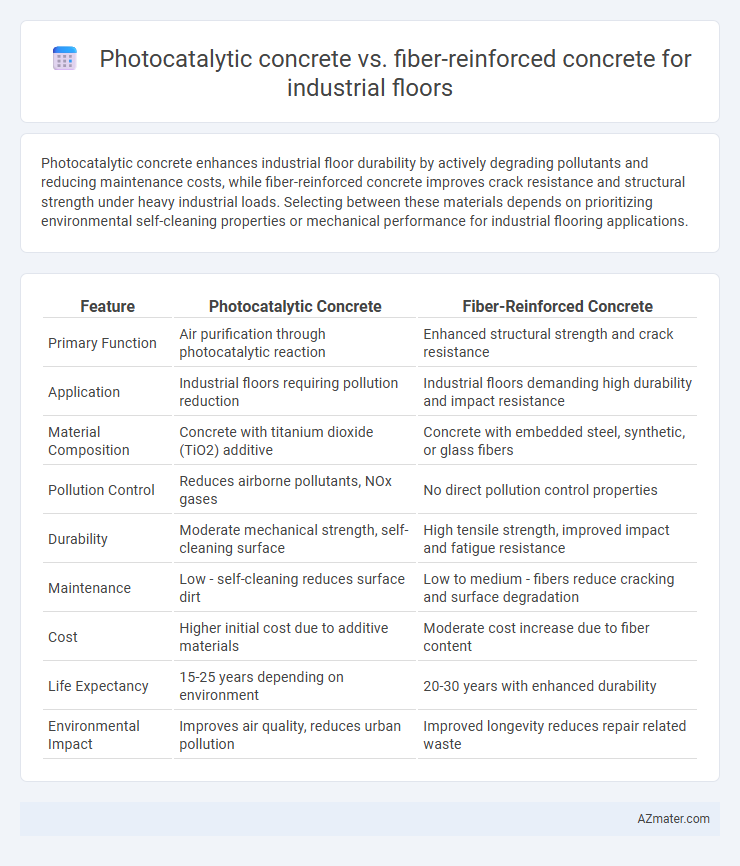Photocatalytic concrete enhances industrial floor durability by actively degrading pollutants and reducing maintenance costs, while fiber-reinforced concrete improves crack resistance and structural strength under heavy industrial loads. Selecting between these materials depends on prioritizing environmental self-cleaning properties or mechanical performance for industrial flooring applications.
Table of Comparison
| Feature | Photocatalytic Concrete | Fiber-Reinforced Concrete |
|---|---|---|
| Primary Function | Air purification through photocatalytic reaction | Enhanced structural strength and crack resistance |
| Application | Industrial floors requiring pollution reduction | Industrial floors demanding high durability and impact resistance |
| Material Composition | Concrete with titanium dioxide (TiO2) additive | Concrete with embedded steel, synthetic, or glass fibers |
| Pollution Control | Reduces airborne pollutants, NOx gases | No direct pollution control properties |
| Durability | Moderate mechanical strength, self-cleaning surface | High tensile strength, improved impact and fatigue resistance |
| Maintenance | Low - self-cleaning reduces surface dirt | Low to medium - fibers reduce cracking and surface degradation |
| Cost | Higher initial cost due to additive materials | Moderate cost increase due to fiber content |
| Life Expectancy | 15-25 years depending on environment | 20-30 years with enhanced durability |
| Environmental Impact | Improves air quality, reduces urban pollution | Improved longevity reduces repair related waste |
Introduction to Industrial Flooring Solutions
Photocatalytic concrete enhances industrial flooring by utilizing titanium dioxide to break down pollutants, offering self-cleaning and air-purifying benefits essential for maintaining cleaner factory environments. Fiber-reinforced concrete improves structural integrity and durability, reducing cracking and maintenance costs in high-traffic industrial floors. Selecting between photocatalytic and fiber-reinforced concrete depends on prioritizing environmental benefits versus mechanical strength in industrial flooring solutions.
Photocatalytic Concrete: Definition and Key Properties
Photocatalytic concrete incorporates titanium dioxide (TiO2) particles that trigger chemical reactions under light, breaking down pollutants and providing self-cleaning surfaces ideal for industrial floors with high exposure to contaminants. Its key properties include air-purifying capabilities, enhanced durability against harsh environmental conditions, and reduced maintenance costs due to its self-cleaning effect. This concrete type effectively improves air quality and extends the lifespan of industrial flooring through degradation of organic and inorganic pollutants.
Fiber-Reinforced Concrete: Definition and Key Properties
Fiber-reinforced concrete (FRC) integrates discrete fibers such as steel, glass, or synthetic materials into the concrete matrix to enhance its mechanical properties, including tensile strength, toughness, and crack resistance. This composite material offers superior durability and improved impact resistance, making it ideal for industrial floors exposed to heavy loads and dynamic stresses. Its ability to control cracking and increase flexural strength contributes to longer-lasting, low-maintenance surfaces in demanding industrial environments.
Durability Comparison: Photocatalytic vs Fiber-Reinforced Concrete
Photocatalytic concrete offers enhanced self-cleaning properties and pollutant degradation, reducing surface wear and maintaining durability under industrial conditions. Fiber-reinforced concrete significantly improves tensile strength and crack resistance, providing superior structural durability in heavy-load environments. When comparing durability, fiber-reinforced concrete excels in mechanical resilience, while photocatalytic concrete contributes to surface longevity and environmental resistance.
Sustainability and Environmental Impact
Photocatalytic concrete enhances environmental sustainability by breaking down pollutants and improving air quality through its titanium dioxide coating, making it ideal for industrial floors in urban areas. Fiber-reinforced concrete offers increased durability and reduced maintenance needs, minimizing resource consumption and extending the lifespan of industrial flooring. Both materials contribute to sustainable construction, with photocatalytic concrete addressing air pollution and fiber-reinforced concrete promoting structural longevity and waste reduction.
Load-Bearing Capacity and Structural Performance
Photocatalytic concrete offers moderate load-bearing capacity with enhanced self-cleaning and pollution-reducing properties, making it suitable for industrial floors requiring surface durability and environmental benefits. Fiber-reinforced concrete significantly improves load-bearing capacity and structural performance by increasing tensile strength, crack resistance, and impact durability, essential for heavy-duty industrial floor applications. Selecting fiber-reinforced concrete optimizes structural integrity under dynamic loads, while photocatalytic concrete prioritizes maintenance and surface longevity.
Maintenance Requirements and Lifespan
Photocatalytic concrete offers self-cleaning properties that reduce the frequency of surface maintenance by breaking down organic pollutants and dirt through sunlight exposure, significantly extending the interval between cleanings. Fiber-reinforced concrete enhances structural durability and crack resistance, decreasing repair needs and prolonging the industrial floor's lifespan by improving load-bearing capacity and mitigating wear. Both materials improve longevity, but photocatalytic concrete primarily minimizes maintenance efforts, while fiber reinforcement focuses on enhancing mechanical performance and durability.
Cost Analysis for Industrial Applications
Photocatalytic concrete, infused with titanium dioxide, offers self-cleaning and pollution-reducing benefits but typically incurs higher initial costs compared to fiber-reinforced concrete, which is known for enhanced durability and crack resistance at a lower upfront investment. Fiber-reinforced concrete reduces long-term maintenance expenses due to improved structural integrity, making it cost-effective for industrial floors subjected to heavy loads and frequent traffic. Evaluating lifecycle costs, fiber-reinforced concrete often proves more economical for large-scale industrial applications, while photocatalytic concrete's environmental advantages may justify its premium in facilities prioritizing sustainability.
Suitability for Different Industrial Environments
Photocatalytic concrete excels in industrial environments with high pollution and frequent vehicle traffic, as its ability to break down harmful pollutants improves air quality and reduces maintenance costs. Fiber-reinforced concrete offers superior mechanical strength and crack resistance, making it ideal for heavy-load applications, such as warehouses or manufacturing plants with heavy machinery. Selecting between these concretes depends on environmental priorities--pollution control favors photocatalytic concrete, while demanding structural performance benefits from fiber reinforcement.
Future Trends in Industrial Flooring Materials
Photocatalytic concrete and fiber-reinforced concrete represent innovative materials shaping the future of industrial flooring, with photocatalytic concrete offering self-cleaning and pollution-reducing properties through titanium dioxide integration. Fiber-reinforced concrete enhances durability and crack resistance by incorporating synthetic or steel fibers, extending floor lifespan under heavy machinery and impact stresses. Emerging trends emphasize combining these technologies to create multifunctional flooring solutions that deliver sustainability, maintenance efficiency, and structural resilience in industrial environments.

Infographic: Photocatalytic concrete vs Fiber-reinforced concrete for Industrial floor
 azmater.com
azmater.com